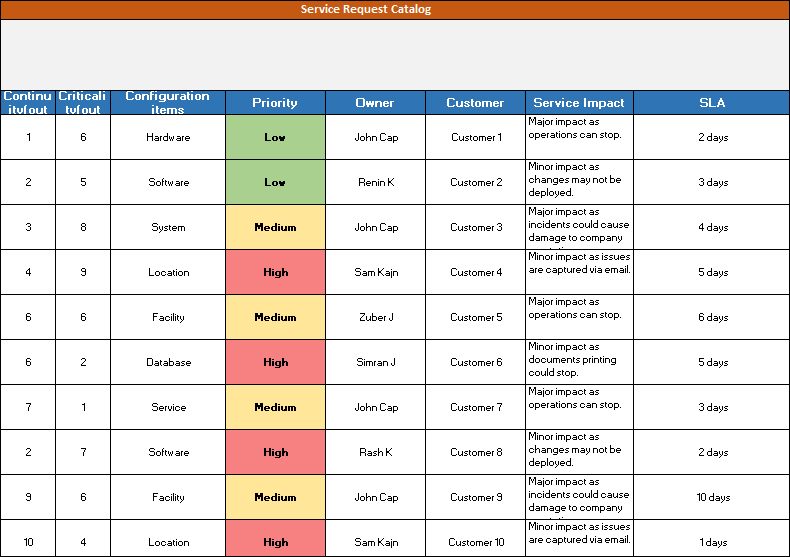Service Request Catalog Template
Introduction
A Service Request Catalog serves as a pivotal component, functioning as a centralized repository that systematically organizes and categorizes various services and their corresponding request types within an organization. This catalog is designed to provide a structured and user-friendly interface for end users, enabling them to request IT services efficiently. The Service Request Catalog is more than just a list of available services; it encapsulates detailed information about each service, including descriptions, relevant details, and any prerequisites or conditions associated with the request. It essentially acts as a comprehensive menu of IT services, empowering users to articulate their needs clearly and ensuring that IT teams can respond effectively.

Need For Service Request Catalog Template
The Service Request Catalogue is critical in the field of IT Governance because it acts as a glue for aligning IT services with organisational goals. By cataloguing and categorising numerous services, the catalogue creates a standardised and clear framework for users to request IT services. This standardisation not only improves the request process, but it also assures that each service adheres to defined governance frameworks and compliance standards. The catalogue is critical for ensuring consistency across service delivery, assisting organisations in optimising resource allocation, improving operational efficiency, and ultimately contributing to the overall IT governance strategy.
Roles And Responsibilities Service Request Catalog Template
1. Service Requestor/User:
Role: The person or entity making the service request.
Responsibilities:
- Use the Service Request Catalogue Template to make requests for specific IT services.
- Provide precise and complete information about the service request to allow for speedy processing.
2. IT Service Desk and Support Team:
Role: The team is charge of managing and completing service requests.
Responsibilities:
- Accepting and reviewing service requests received through the catalogue.
- Prioritise and categorise service requests according to their urgency and impact on users.
3. IT Services Manager:
Role: Overseeing the entire service management process.
Responsibilities:
- Defining and maintaining the Service Request Catalogue Template to fit with the organization's service offerings.
- Implement and enforce service request handling procedures.
4. Service Request Fulfilment Teams:
Role: Specialised teams or individuals are responsible for fulfilling specific types of service requests.
Responsibilities:
- Receiving and resolving assigned service requests within established timescales.
- Collaborate with other teams or departments as needed to accomplish service needs.
5. IT Asset Management Team:
Role: Manage and track IT assets sought via service requests.
Responsibilities:
- Accurately document the allocation and distribution of IT assets through service requests.
- Update asset data and keep an accurate inventory.
6. Service Catalogue Administrator:
Role: Manage and update the Service Request Catalogue Template.
Responsibilities:
- Regularly reviewing and updating the catalogue to reflect changes in offered services.
- Work with service owners and stakeholders to ensure service descriptions are accurate and full.
7. Quality Assurance and Compliance Team:
Role: Ensure that service requests and their fulfilment adhere to applicable policies and standards.
Responsibilities:
- Conducting frequent assessments of service requests and ensuring compliance.
- Provide feedback and suggestions for process improvements.
8. Reporting and Analysis Team:
Role: Analysing data on service requests for reporting and improvement reasons.
Responsibilities:
- Create reports on service request metrics, such as response times, resolution times, and customer satisfaction.
- Identify trends and areas for improvement by analysing service request data.

Benefits Of Service Request Catalog
1. Improved User Experience: A well-organized and simply navigable catalogue allows users to quickly identify and request the precise IT services they require, improving their overall experience.
2. Efficient Service Delivery: The catalogue enforces standardised request processes, ensuring that each service request adheres to preset workflows and quality standards..
3. Transparency and Accountability: The catalog's detailed service descriptions and requirements help users understand the services that are provided, avoiding misconceptions and miscommunications.
4. Optimized Resource Allocation: The catalog enables IT teams to deploy resources more efficiently based on the criticality and urgency of each request.
5. Consistency and Compliance: Integrating the catalogue with ITIL best practices guarantees that it complies with industry standards and recognised IT service management frameworks.
6. Enhanced Communication: By incorporating feedback mechanisms into the catalogue, consumers can contribute insights into their experiences, allowing for continual improvement and refinement of IT services.
Conclusion
The Service Request Catalogue is an important tool in IT Governance since it allows organisations to manage and deliver IT services in a structured and effective manner. Its implementation yields numerous advantages that add to the overall effectiveness and alignment of IT operations with organisational goals. The Service Request Catalogue improves the user experience by providing a simple interface and standardised processes, allowing anyone to easily request and manage IT services.


